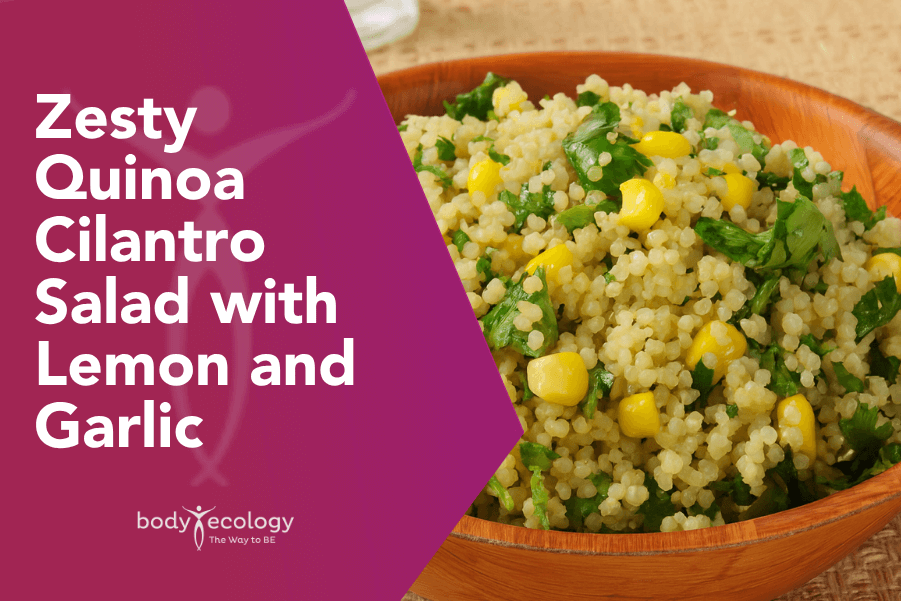You’re doing everything the nutrition experts recommend. Choosing whole wheat over white bread, brown rice over refined, steel-cut oats over the instant options.
So, why do you still feel bloated after meals? And why does that “healthy” grain bowl leave you reaching for a nap by 2 PM? The answer might surprise you.
What We Thought We Knew About Whole Grains
For years, we’ve been told that complex carbs are the foundation of a healthy diet. In many ways, that’s true—but only when your digestive system is strong enough to handle them.
What’s often overlooked is that when your inner ecosystem is out of balance, even whole grains can become problematic.
Your inner ecosystem refers to the community of bacteria, yeast, and other microorganisms living in your digestive tract. When beneficial bacteria are thriving and keeping harmful organisms in check, your gut can handle a wide variety of foods. But when that balance tips—often due to antibiotic use, stress, or poor diet—problematic organisms like Candida yeast can take over.
For millions of us, Candida and other pathogens have quietly taken up residence in our digestive tract, often without obvious symptoms at first.
The Hidden Connection Between Grains and Gut Imbalance
Whole grains like wheat, barley, rye, oatmeal, spelt, and rice all contain natural sugars and starches. While these differ from refined sugar, they can still feed Candida and other unwanted organisms in your body.
When you have an overgrowth of these pathogens, foods that should nourish you instead become fuel for the wrong kind of bacteria. This creates even more imbalance and can lead to a cascade of digestive issues, energy crashes, and mysterious symptoms that seem unrelated to what you’re eating.
Most grains also contain gluten—a protein that can trigger inflammation and damage the intestinal lining, especially when your inner ecosystem is already compromised. A landmark study found that 1 in 133 Americans may have a negative reaction to gluten, and this number has quadrupled since the 1950s. Our food and environment have fundamentally changed, and our bodies are responding accordingly.
The Modern Grain Problem
The grains our ancestors ate bear little resemblance to what’s on grocery store shelves today.
Traditionally, people used granite stone mills to make flour. This process broke down grains slowly and gently, preserving the nutrients, essential oils, and vitamins found in the germ of the grains. The slower harvesting processes often allowed grains to sprout naturally in the field before they were milled, which increased their nutrient content and made them much easier to digest.
Today’s commercial producers mill tons of grains at a time in industrial machines that spin at high speeds, creating intense heat that destroys virtually all the nutrients and beneficial oils. The result? Mucus-forming foods that create a sticky, gummy mess in your intestines—the perfect environment for pathogenic yeast like Candida to attach and thrive.
This toxic environment in your gut prevents proper digestion and absorption of essential nutrients. The downstream effects include vitamin and mineral deficiencies, chronic fatigue, weakened immunity, and what many people describe as a general loss of vitality.
The Hidden Enzyme Blocker in “Healthy” Foods
All grains, nuts, beans, and seeds contain something called phytic acid—a natural compound that acts as an enzyme inhibitor.
Phytic acid literally neutralizes your body’s digestive enzymes, making it extremely difficult to break down and assimilate these foods. Think of it as nature’s security system—plants use phytic acid to protect their seeds from being digested before they can sprout and grow.
Phytic acid also binds to essential minerals like calcium, magnesium, copper, and iron, preventing your body from absorbing them. This is particularly problematic for women who need to replace iron during menstruation, and children who need iron for proper growth and development.
This widespread mineral blocking helps explain why digestive disorders and nutrient deficiencies have become epidemic in our society, despite people eating what they believe are healthy, nutrient-rich foods.
Our ancestors understood this problem intuitively. They knew they had to soak grains in water overnight, allow them to sprout, or ferment them into traditional breads like sourdough before eating. Each of these time-tested processes neutralizes the phytic acid and makes the nutrients available for absorption. We’ve abandoned this ancient wisdom in favor of convenience.
Why Your Digestion Might Be Struggling
When you eat improperly prepared grains with high phytic acid content, several things happen in your digestive system:
Your digestive enzymes get neutralized. This makes it harder to break down the grains themselves, plus other foods in the same meal. The result is that heavy, sluggish feeling after eating.
Essential minerals get bound up and flushed out. Even if you’re eating nutrient-dense foods, your body can’t access many of the minerals it desperately needs for energy production and cellular repair.
Your gut lining becomes inflamed. This creates an environment where harmful bacteria and yeast can flourish while beneficial bacteria struggle to survive.
Undigested food particles leak through your compromised intestinal wall. This triggers immune reactions throughout your body and contributes to food sensitivities, skin problems, and autoimmune issues.
If you’re experiencing gas, bloating, fatigue after meals, brain fog, sugar cravings, or even seemingly unrelated symptoms like skin issues, mood swings, or joint pain, this cascade of digestive dysfunction could be the root cause.
The Crucial Preparation Step
If you choose to eat grains, there’s one step that makes all the difference—and most people skip it entirely even though cultures have been doing it for thousands of years.
The trick? Soak your grains overnight, or up to 24 hours.
What this does is neutralize the phytic acid that would otherwise bind to minerals in your gut and shut down your digestive enzymes. Traditional cultures knew that unsoaked grains were basically indigestible—that’s why they always soaked, sprouted, or fermented them first.
You can go one step further by cooking grains like pasta—boiling them in plenty of water, then draining and refilling with fresh water to finish cooking. This removes even more problematic compounds.
But even with proper preparation, many people still struggle.
Why? Because years of processed food, antibiotics, and stress have left our digestive systems producing far fewer enzymes than they should.
This is where comprehensive enzyme support becomes crucial.
Supporting Your Digestive Power With Assist Full Spectrum Enzymes
Assist Full Spectrum Enzymes provides 14 different enzymes specifically designed to help break down proteins, fats, carbohydrates, and complex plant fibers. What sets it apart is that it includes five different types of protease—the enzymes that break down proteins—while most formulas only have one or two.
This matters because proteins need to be broken down across the entire pH range of your digestive tract, from the highly acidic environment of your stomach (pH 2.0) to the more alkaline environment of your small intestine (pH 11.0). Having multiple types of protease ensures thorough protein digestion no matter where the food is in your system.
The formula also includes specialized enzymes like alpha-galactosidase (which breaks down the complex sugars that cause gas), cellulase (which helps digest plant fiber), and lipase (which breaks down fats). This gives your digestive system the full spectrum of support it needs.
Whether you’re eating properly prepared grains or any other challenging-to-digest foods, your body has the enzymatic power it needs to actually break down and use what you’re eating—instead of letting it sit and ferment into gas, bloating, and inflammation.
The Takeaway
You don’t need to fear all carbs or resign yourself to digestive discomfort. You do need to understand that your individual digestive capacity matters more than generic nutrition advice.
The goal isn’t perfection. Find what works for your unique body and support your digestive system so it can handle a wider variety of foods over time.
Ready to support your digestive system properly? Assist Full Spectrum Enzymes provides the comprehensive enzymatic support your body needs to break down any meal comfortably.
REFERENCES:
- A. Malhotra, T. Noakes, S. Phinney. It is time to bust the myth of physical inactivity and obesity: you cannot outrun a bad diet. British Journal of Sports Medicine, 2015; DOI: 10.1136/bjsports-2015-094911.
- Raffaella Crescenzo, Francesca Bianco, Paola Coppola, Arianna Mazzoli, Margherita Tussellino, Rosa Carotenuto, Giovanna Liverini, and Susanna Iossa. Fructose supplementation worsens the deleterious effects of short term high fat feeding on hepatic steatosis and lipid metabolism in adult rats. Experimental Physiology, June 2014 DOI: 10.1113/expphysiol.2014.079632.
- K.R. Magnusson, L. Hauck, B.M. Jeffrey, V. Elias, A. Humphrey, R. Nath, A. Perrone, L.E. Bermudez. Relationships between diet-related changes in the gut microbiome and cognitive flexibility. Neuroscience, 2015; 300: 128 DOI: 10.1016/j.neuroscience.2015.05.016.
- R. Agrawal, F. Gomez-Pinilla. ‘Metabolic syndrome’ in the brain: deficiency in omega-3 fatty acid exacerbates dysfunctions in insulin receptor signalling and cognition. The Journal of Physiology, 2012; 590 (10): 2485 DOI: 10.1113/jphysiol.2012.230078.
- Kara R. Goldfein, Joanne L. Slavin. Why Sugar Is Added to Food: Food Science 101. Comprehensive Reviews in Food Science and Food Safety, 2015; DOI: 10.1111/1541-4337.12151.
- American Association For Cancer Research. “Study Links High Carbohydrate Diet To Increased Breast Cancer Risk.” ScienceDaily.
- “A low-carb diet may stunt prostate tumor growth.” Duke University Medical Center.
- PLoS One. 2014 Nov 21;9(11):e113605. doi: 10.1371/journal.pone.0113605. eCollection 2014.
- “A High Fat, Low Carbohydrate Diet Improves Alzheimer’s Disease In Mice.” BioMed Central.
- “High-carb intake in infancy has lifelong effects, study finds.” University at Buffalo.
- Arch Intern Med. 2003 Feb 10;163(3):286-92.
- Gastroenterology. 2009 Jul;137(1):88-93. doi: 10.1053/j.gastro.2009.03.059. Epub 2009 Apr 10.2
- Cochran, Amanda. “Modern Wheat a “perfect, Chronic Poison,” Doctor Says.” CBSNews.
- Gastroenterology. 2013 Aug;145(2):320-8.e1-3. doi: 10.1053/j.gastro.2013.04.051. Epub 2013 May 4.
- C. H. F. Hansen, ukasz Krych, K. Buschard, S. B. Metzdorff, C. Nellemann, L. H. Hansen, D. S. Nielsen, H. Frokiaer, S. Skov, A. K. Hansen. A maternal gluten-free diet reduces inflammation and diabetes incidence in the offspring of NOD mice. Diabetes, 2014; DOI: 10.2337/db13-1612.
- Pennesi Christine M.; Klein Laura Cousino. Effectiveness of the gluten-free, casein-free diet for children diagnosed with autism spectrum disorder: Based on parental report. Nutritional Neuroscience, 2012 DOI: 10.1179/1476830512Y.0000000003.
























